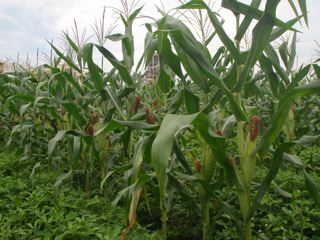Weeds
Grasses
Sedges
Broadleaf
Diseases
Fungal
Bacterial
Viral
Agro-ecology
Intercropping corn with beans and other legumes regulates pests (leafhopper, leaf beetles, stalk borer, and fall armyworm) and increases the land utility. Intercropping
Canavalia (
Canavalia spp.) with corn improves soil productivity. Sow Canavalia seeds 4 weeks after sowing corn. Place 1 seed/hole in a row between corn rows with 50 cm between holes. Allow Canavalia to grow after harvesting corn until it is time to plant the next crop. Then
plow-under the plant materials into the soil (CIAT, 2000).
Intercropping corn with beans and squash enhances caterpillars'
parasitism. This practice increases the abundance of
natural enemies where food sources for beneficial insects are made available (Altiere; Nicholls, 2000). The intercropping system of corn-beans-squash is a low input and high yield strategy in the tropics. Corn yield is increased by as much as 50% over
monoculture yield. Although the yields for beans and squash are reduced, the overall yield for the three combined crops is greater than when grown separately in monocultures (Agroecology Research Group, 1996).
Desmodium (
Desmodium uncinatum) and Melinis grass (
Melinis minutifolia) when planted in between corn rows keep the stem borer moths away. These plants produce chemicals that repel stem borer moths. Napier grass (
Pennisetum purpureum) and Sudan grass (
Sorghum vulgare sudanese) are good trap crops for corn from stem borer attack. Napier grass has its own defense mechanism against crop borers by producing a gum-like-substance inside its stem, this prevents larva from feeding and causing damage to the plant. Also, Sudan grass increases the efficiency of natural enemies when planted as
border crops (Herren; Pickett, 2000).
Nitrogen (N) requirement of corn is 220 kg/ha for maximum yields. Any decrease in the rate of N fertilizer applied will reduce yields. This suggests that the usual N fertilizer recommendation is much below the optimum level. N should be applied as split applications, Œ - œ either before or at planting. Depending upon the N leaching and the crop appearance, the remainder can be applied in one or two applications at about 40 days after germination (IFA, 2003). N deficiency results in a loosely filled cob, however, overuse of N should be avoided.
Many soils provide substantial amounts of the phosphorus (P) and potassium (K) but this is not adequate enough, especially at the seedling stage. Apply P near the seed for early seedling vigor. K is taken up in large quantities but plants' requirement can usually be estimated by soil analysis. K deficiency results in empty cob ends, while P deficiency results in hollow grains. However,
fertilizer recommendations based on
soil analysis provide the very best chance of getting the right amount of fertilizer without over or under fertilizing. Ask for assistance from a local agriculturist office.
In rainfed corn growing areas, plant seeds along with the first rain. This will allow roots to absorb the natural nitrates formed with bacterial action in the soil. Roots are susceptible to poor drainage which cause stunted and yellowing of leaves. Stagnant water results to loss in N through
leaching and
denitrification (FADINAP, 2000).
Further information
A perennial variety of teosinte (
Zea diploperennis) a wild grass closely related to corn has been discovered in the mountains of the state of Jalisco in Mexico. The variety carries only 20 chromosomes similar to that of corn. It is hoped that when the plants are crossbred, the new hybrid will grow perennially and also have the ability to tolerate moist and even wet soils (UNESCO, 2000).
A study entitled "The use of sugar solutions to enhance the impact of predators of fall armyworm in maize" was conducted for a period of two years to apply artificial honeydews to corn crops to attract natural enemies in the field. Result showed that applications of sugar solution to maize increased the
numbers of natural enemies which coincided with the decreases in fall armyworm damage and infestation rates (O'neil; Canas, 1996). The use of artificial honeydews by small scale farmers in the Tropics is an alternative to synthetic pesticides because of no risk of poisoning in application and storage, the ease in preparation, and the ready availability of sucrose sources, such as refined sugar and other sugarcane by-products.
OISAT Field Guides
Field Guide to Non- chemical Pest Management in Corn Production
download (1149 kb)
External links
References
- CABI. (2004): Crop protection compendium. 2004 Edition. CAB International Publishing. Wallingford, UK.
- Herren, H.; Pickett, J. (2000): Kenya: Vutu-sukumu (Push-pull) pest management in smallholder systems. ICIPE annual reports.
- ICIPE. (2003): Development of biocontrol-based management of Helicoverpa armigera in eastern and southern Africa. 2000-2003 ICIPE Scientific Report. International Center for Insect Physiology and Entomology, Nairobi, Kenya.
- ICIPE. (2003): 2000 - 2003 ICIPE Scientific Report. International Center for Insect Physiology and Entomology, Nairobi, Kenya.
- O’neil, R.; Canas, L. (2000): The use of sugar solutions to enhance the impact of predators of fall armyworm in maize. Department of Entomology, Purdue University. West Lafayette, USA.
- Parker, B.; Talekar, S.; Skinner, M. (2000): Insect pests of selected vegetables in tropical and subtropical Asia. Asia Development and Research Center Vermont, USA.
- Philippine-German Crop Protection Program. (2000): Integrated Pest Management on Corn. Bureau of Plant Industry, Malate, Manila, Philippines.
- Rehm, S.; Espig, G. (2000): The cultivated plants of the tropics and the subtropics. Verlag Josef Margraf Scientific Books. Berlin.
- Youdeowei, A. (2002): Integrated pest management practices for the production of cereals and pulses. Integrated Pest Management Extension Guide 2; Series editors: A. Cudjoe and M. Braun; Ministry of Food and Agriculture, GTZ and CTA.

